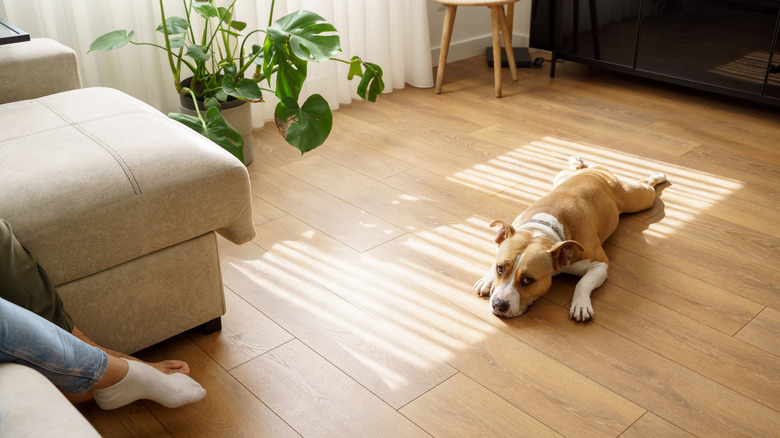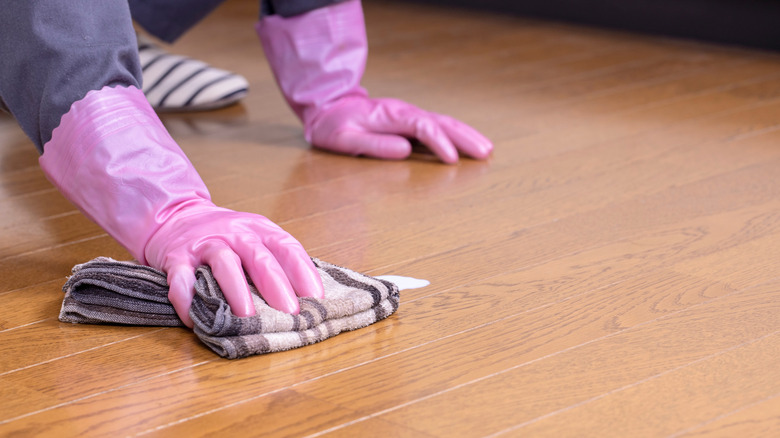Potential Downsides To Consider Before Waxing Your Wood Floors
Are you looking for a way to bring old hardwood floors back to life? Waxing is a finishing option that adds shine back to the wood while increasing protection and camouflaging minor scratches on your floors. Available in clear and colored varieties, floor wax comes in both synthetic and natural forms with solvents that help harden the protective layer. Despite the dazzling results you can get from waxing wood floors, there are potential drawbacks, including damage to certain types of floors, less durability than other finish options, and ongoing maintenance.
Waxing the wrong types of floors could cause problems. Only use wax on hardwood floors — not engineered hardwood, laminate, bamboo, or other flooring designed to look like wood. Many of these materials come with finishes that won't allow the wax to penetrate, leading to a dulling buildup.
Not all hardwood floors are good candidates for waxing, either. If you've previously used a polyurethane finish on the floor, skip waxing. Applying wax over polyurethane may affect the appearance. It could leave behind a cloudy or streaky look or cause the finish to peel. It's also important to make sure the wood flooring is in good condition before waxing it.
Durability concerns for waxed floors
Wax offers a protective layer to prevent scratches, scuffs, and other minor damage to keep your wood floor looking like new. As the wax dries, it hardens and leaves behind a protective barrier. However, wax isn't as durable as other finishes like polyurethane, which offers increased protection. Wax coatings only protect against minor scratches and damage, and they're not very protective against moisture because wax doesn't make your wood floor waterproof.
Polyurethane is a more modern finish option that's stronger than the traditional waxing method. You can expect polyurethane finishes to last for several years whereas wax floors need to be refinished more frequently to maintain a durable finish. For that reason, you might choose polyurethane for high-traffic areas and reserve wax for less busy rooms.
When comparing polyurethane and wax, both have some advantages. While polyurethane offers increased durability, it can chip — an issue you don't usually have to worry about with wax finishes. Wax also offers more of a sheen than polyurethane does, so consider the look you want when you're deciding between wood flooring finishes. If protection is your priority, polyurethane may be a better option. If shine is important to you, waxing your wood floors can give you that look.
Maintenance requirements for waxed wood floors
While wax is easy to apply, it's also a time-consuming task. If you choose paste wax, you need to apply it by hand, which means you'll be down on the floor for the duration of the application. For liquid wax, you can use a sponge mop to apply it, but it still takes time to cover the entire floor. This process should be repeated frequently — usually every six months to a year.
Waxed floors call for a careful maintenance routine. Since wax doesn't make the floor waterproof, your cleaning method should minimize how much moisture goes onto the surface. Keep your mop barely damp when cleaning, and buff the floors between waxings to keep them shiny.
If you decide to change the look of your wood, you'll need to remove all of the wax before refinishing hardwood floors. Don't try to sand or refinish until you've stripped all the wax from the floor. Even if you're just applying a fresh layer of wax, it's a good idea to remove any remaining product from the wood. You can do this by using floor strippers or mineral spirits. It can be challenging to remove all of the old wax from the wood floor, so be sure to allow extra time for this step.


